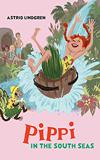
Cute enough. For the most part, it’s more Pippi stories, but they do finally get out of the town and go with Pippi and her father to the South Seas island where her father is king. Which… is both the best and worst part of the book. It’s zany and fun in true Pippi fashion, but it’s also horribly imperialistic/racist. It’s still a fun book, but definitely a product of the times.
Inside the big cave the Koratutt children had gathered a store of gleaming pearls that they had found inside the oysters. They used them to play marbles. They hadn’t the faintest idea that these pearls were worth no end of money in the other countries. Captain Longstocking always took a few with him when he went to buy snuff. The pearls bought him loads of things he thought his subjects might need, but on the whole he thought his faithful Koratutts were quite happy the way they were. So the children were more than welcome to go on playing marbles with the pearls.
Oy.
Also…
There was no sign of Mr. Nilsson. He had taken himself off on a little excursion into the jungle, where he had found a number of his relatives.
What exactly do you think Mr. Nilsson is getting up to with his ’native’ relatives?
All this time Pippi’s horse had been wondering where Pippi and Tommy and Annika had got to. Nilsson had returned from visiting his relatives in the jungle and he was wondering the same. He was also wondering what Pippi would say when she found out he had lost his little straw hat.
Also also, it’s kind of a bittersweet ending. They take Pippi’s ‘magic beans’ so that they can remain children forever.
Yes, it was a truly comforting thought—Pippi would be in Villa Villekulla forever.
“If only she’d look this way, we could wave at her,” said Tommy.
But Pippi only stared straight ahead, dreaming. Then she blew out the candle.
And so it ends.
A fun series to read with my children, now on to something new!